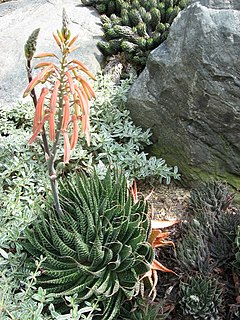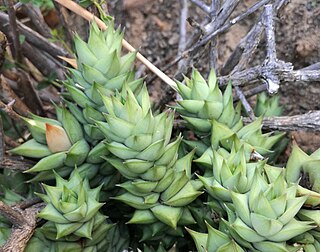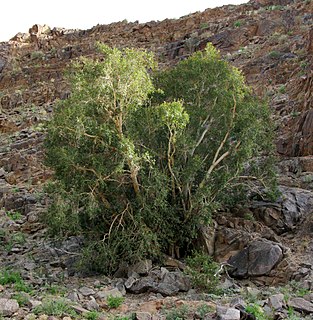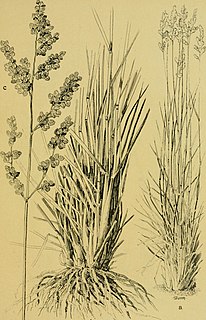
Deserts and xeric shrublands are a biome defined by the World Wide Fund for Nature. Deserts and xeric shrublands form the largest terrestrial biome, covering 19% of Earth's land surface area. Ecoregions in this habitat type vary greatly in the amount of annual rainfall they receive, usually less than 250 millimetres (10 in) annually except in the margins. Generally evaporation exceeds rainfall in these ecoregions. Temperature variability is also diverse in these lands. Many deserts, such as the Sahara, are hot year-round, but others, such as East Asia's Gobi, become quite cold in winter.

Kirstenbosch is an important botanical garden nestled at the eastern foot of Table Mountain in Cape Town. The garden is one of ten National Botanical Gardens covering five of South Africa's six different biomes and administered by the South African National Biodiversity Institute (SANBI). Prior to 1 September 2004, the institute was known as the National Botanical Institute.

Aristaloe is a genus of evergreen flowering perennial plants in the family Asphodelaceae from Southern Africa. Its sole species is Aristaloe aristata, known as guinea-fowl aloe or lace aloe.

The Succulent Karoo is a ecoregion defined by the World Wide Fund for Nature to include regions of desert in South Africa and Namibia,and a biodiversity hotspot. The geographic area chosen by the WWF for what they call 'Succulent Karoo' does not correspond to the actual Karoo.

The wildlife of South Africa consists of the flora and fauna of this country in southern Africa. The country has a range of different habitat types and an ecologically rich and diverse wildlife, vascular plants being particularly abundant, many of them endemic to the country. There are few forested areas, much savanna grassland, semi-arid Karoo vegetation and the fynbos of the Cape Floristic Region. Famed for its national parks and big game, 297 species of mammal have been recorded in South Africa, as well as 858 species of bird and over 20,000 species of vascular plants.

Leucadendron strobilinum, commonly called the peninsula conebush, is a plant species in the genus Leucadendron—forming part of the family Proteaceae. Confined to the Cape Peninsula, it reaches a height of up to 2.6 metres growing in southern, damp rocky slopes at an elevation of 500 to 1100m. Its conservation status is Near Threatened—a result of inappropriate fire management, fire-break clearing and alien plant invasions.

Astroloba rubriflora is a succulent plant found in the mountainous Karoo area around Robertson, South Africa. It is listed as a Vulnerable species on the IUCN global Red List.

Astroloba herrei is a small succulent plant of the genus Astroloba, restricted to the area around the Swartberg mountains, South Africa.

Ficus cordata, the Namaqua rock fig, is a species of fig that occurs in two disjunct populations in Africa, one in the arid southwest of the continent, and a second in the northern subtropics. In the south it is often the largest and most prominent tree, and is virtually restricted to cliff faces and rock outcrops, where it has a rock-splitting habit.

Pteronia paniculata is a species of flowering plant in the family Asteraceae, indigenous to the Karoo regions of South Africa.

Pteronia pallens is a species of flowering plant in the family Asteraceae, indigenous to the Karoo regions of South Africa. Its natural habitat is dry, rocky slopes. It often cooccurs with its close relatives, Pteronia paniculata or Pteronia incana.

Aristida congesta is a species of grass native to all provinces of South Africa as well as Namibia, Botswana, Lesotho, Swaziland, and Mozambique. The SANBI Red List classifies it as "safe."
Eragrostis truncata is a grass native to Namibia, Botswana, and South Africa. Found most abundantly in the Nama Karoo, the plant is registered under the SANBI Red List as "safe" (LC).

Gazania lichtensteinii is one of the flowers known as a calendula, native to South Africa and Namibia. On the SANBI Red List, it is listed as "safe".

Eragrostis echinochloidea, is a species of grass native to South Africa. Listed as "safe" (LC) on the SANBI Red List, the plant can also be found in Zimbabwe, Botswana, and Namibia.

Stipagrostis namaquensis is a species of grass native to South Africa and Namibia, especially in the Nama Karoo. It is listed as "safe" (LC) on the SANBI Red List.
Pteronia glauca ("Geelboegoekaroo") is a species of flowering plant in the family Asteraceae, indigenous to the Karoo regions of South Africa.
Protea convexa, also known as large-leaf sugarbush, is a rare flowering shrub in the genus Protea of the family Proteaceae, which is endemic to the southwestern Cape Region of South Africa.
The Biodiversity of South Africa is the variety of living organisms within the boundaries of South Africa and its exclusive economic zone. South Africa is a region of high biodiversity in the terrestrial and marine realms. The country is ranked sixth out of the world's seventeen megadiverse countries, and is rated among the top 10 for plant species diversity and third for marine endemism.















